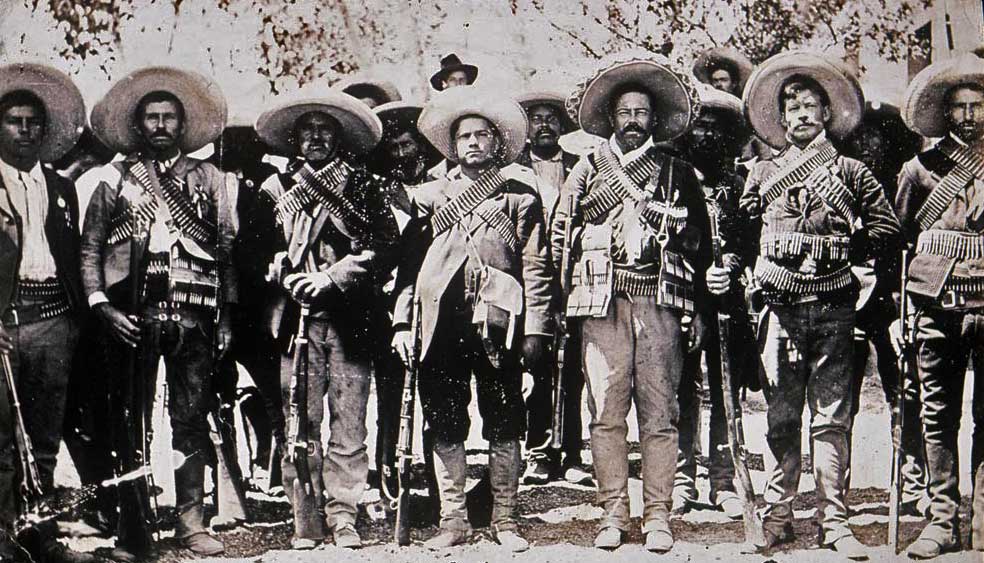
The History of the Sport
The sport of metallic silhouette shooting, or silhuetas metallicas, had its origin around 1914 when the rebel leader and strategist Pancho Villa and his men were raiding villages and ranches in the northern state of Chikupehua, Mexico. On one occasion, having put some distance between themselves and the pursuing Yankee cavalry, the banditos raided a well-stocked ranch in the north where they spent some fourteen days carousing.
Eventually a tequila-induced dispute arose between two of Villa’s followers as to who was the better shot. Normally such an argument would have ended in a gunfight. A squad leader, Juan Martinez, decided instead on a shootout using two live steers as targets. The unfortunate animals were tethered to trees at a suitable distant point and the contest began. The contestants were permitted to shoot alternately until one of them succeeded in killing his steer and was judged the winner.
The idea caught on and soon chickens, sheep and goats were literally “roped in” to serve as targets. After the revolution, the Villistas returned to their farms and villas throughout Mexico, taking with them a new sport to be practiced at fiestas in the decades to come.
The practice of shooting at live animal targets continued and was refined with time, using rifles as well as handguns. All hits that drew blood were counted.


Shortly after the Second World War, metallic cutout silhouettes began to be substituted for live animals, both for humanitarian as well as practical reasons: there wasn’t much chicken left after a direct hit with a high-powered rifle! Even so, the original sport of shooting live animals would continue in the outlying areas until the late 1950’s, usually in conjunction with a fiesta.
In 1948, the first match using silhuetas metallicas took place in Mexico City. The gunners still shot turkeys, but metal ones now. The original feathered edition had its neck wrung prior to the contest, after which it was placed on ice and presented to the winner after the match.
The man who really got metallic silhouette shooting started in Mexico was Don Gonzalo Aguilar who was instrumental in staging the Silhuetas Metallicas Nacionales in Mexico City in 1952, four years after he had organized the first informal shoot. The targets were gallinas (chickens) at 200m, gualotes (turkeys) at 385m and borregos (sheep) at 500m. It was several years before the javelina (pig) target came into use.
By the early ’60s the sport was well run and controlled, particularly in the north where Le Liga del Norte (the Northern League) had been formed. Soon many Americans were regularly making the pilgrimage across the Rio Grande to participate in the metallic silhouette shooting competitions and before long, the sport was introduced into the RSA.
Match Format
IMSSU
All silhouette matches run according to IMSSU rules feature targets arranged in banks of ten, at varying distances. The closest targets are 10 chickens, followed with 10 pigs at the next distance. After that comes the 10 Turkeys which is followed by 10 Rams at the furthest distance. Although each target is different in size and each is placed at a different distance, these two factors combine to give all of the targets roughly the same apparent size. A different way of saying this is to state that all of the targets cover approximately the same minutes of angle.




Targets
While the chicken targets are considered second easiest only to the pig, they are surprisingly difficult because of their odd shape. The eye tends to want to ‘center’ the target, usually resulting in a low shot. The pig is considered the easiest target to hit based upon its relative wideness, regular shape, and the fact that it is close enough to the shooter to make wind less of a factor. The turkey is acknowledged as the most difficult of the silhouette targets to hit due to its irregular diagonal shape and because the wind really comes into play. It takes a good shooter to clean a bank of turkeys. Don’t let the ram’s large size fool you: this target places a premium on an accurate rifle, an accurate hold, and an accurate determination of the prevailing winds.
Competition
During IMSSU sanctioned silhouette matches, such as the World, National or Provincial Championships, shooters are required to fire 40 shots shots at each type of target (2 banks of 5 targets at each distance). In league matches only 20 shots are fired (1 bank of 5 targets at each distance).
A sighting-in period is normally allowed before the competition begins, where the shooter verifies sight settings at the various distances. Once the match begins, all shots count towards the shooter’s score and no sighters are allowed.
When shooters are called to the line, they are given a couple of minutes to adjust their sights to the proper yardage. The relay begins when shooters are given a 15-second ‘heads up’ period to load their firearm, followed immediately and without a delay by a 2-minute, 30-second period during which they shoot at their 5-target bank, from left to right.
All rifle shooting is done from the offhand position, and no shooting coats, hooked butt plates, gloves, or slings are allowed. Some handgun events are done from a standing position, in others a “freestyle” position is allowed.
Targets must be shot in order – skipping a target results in an automatic ‘miss’ for that target and the following target whether or not the latter was hit. The shooter is only allowed one shot per target. The targets must be knocked over – targets that are merely rotated or nudged, count as misses,